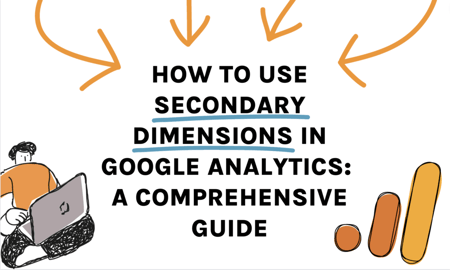The Power of Secondary Dimensions in Search Engine Optimization: Optimizing Your Insights
Wiki Article
Enhance Your Data Evaluation Utilizing Second Dimensions
The true deepness of understandings exists in the integration of second measurements. The critical use of secondary dimensions raises evaluation past the surface area level, assuring a wide range of untapped potential waiting to be uncovered.Understanding Second Measurements
Secondary dimensions in information evaluation refer to extra attributes or metrics that offer deeper insights when integrated with primary data dimensions, boosting the total understanding of the dataset. These added measurements supply an even more comprehensive view of the data, permitting analysts to reveal surprise patterns, partnerships, and fads that might not be apparent when just considering key measurements.By including additional measurements right into data analysis, analysts can obtain an extra nuanced understanding of the variables affecting the main metrics. For example, in advertising analysis, key measurements can consist of fundamental customer demographics like age and gender, while second measurements could encompass variables such as acquiring habits, preferences, or geographical area. By integrating these primary and second measurements, analysts can develop much more thorough consumer profiles, enabling even more targeted and effective advertising and marketing methods.
Additionally, second dimensions can aid in identifying relationships between various variables, resulting in more precise predictive modeling and decision-making. They allow experts to explore information from multiple point of views, enriching the insights attracted from the dataset and ultimately enhancing the quality of evaluation and strategic suggestions.
Advantages of Secondary Measurements
When thinking about information evaluation, including second measurements supplies a plethora of advantages that significantly enhance the depth and breadth of insights derived from primary information measurements. By including second measurements such as time, area, or market details to the evaluation, researchers can acquire a much more extensive understanding of the primary data points.Furthermore, second measurements can likewise assist in segmenting information, allowing for a more detailed evaluation of details parts within the main data. This segmentation can bring about even more targeted methods and actions based on the one-of-a-kind features of each sector. Furthermore, secondary dimensions can assist in verifying findings from key information dimensions, providing an extra robust and trusted basis for decision-making.
Basically, the benefits of integrating second measurements into information evaluation are invaluable, using richer understandings and allowing even more educated decision-making processes.
Implementing Second Measurements Successfully
When integrating second dimensions, it is critical to align them with the main measurements to obtain deeper insights into the information. It is crucial to select second dimensions that match the main information without creating sound or confusion in the analysis.Furthermore, think about the scalability of the second measurements throughout different datasets or analyses. Guarantee that the selected second measurements can be continually used and interpreted across various scenarios to maintain the integrity and consistency of the analysis. Develop an organized procedure for incorporating additional dimensions right into the evaluation process to enhance the interpretation of results. By implementing secondary measurements properly, experts can improve the depth and accuracy of their data evaluation, leading to even more enlightened decision-making and workable insights.
Advanced Techniques With Additional Dimensions
For a more sophisticated approach to data evaluation, incorporating additional measurements can considerably boost the depth of insights obtained. Advanced techniques with secondary measurements entail more complex approaches to extract important details from information sets.One more sophisticated strategy is regression analysis, which helps determine connections in between variables and just how they impact each other. By adding additional measurements, such as group details or user behavior, to regression designs, you can discover extra nuanced understandings and make even more precise forecasts.

Study: Secondary Measurements in Action

In one more scenario, a medical care copyright leveraged additional dimensions to maximize resource allocation. By assessing individual outcomes in regard to geographical place, the company determined locations with high readmission rates. This led to the execution of targeted intervention programs in those areas, ultimately enhancing patient care and reducing health care prices.
These study show the power of second dimensions in revealing important understandings that drive strategic decision-making. By diving deeper right into data evaluation past primary metrics, organizations can gain a much more thorough understanding of their operations and clients, causing more effective and educated service strategies.
Final Thought
To conclude, the unification of second dimensions in data evaluation is essential for acquiring navigate here a detailed understanding of underlying factors and trends. By making use of techniques such as mate evaluation and regression evaluation, companies can uncover covert insights and make even more informed decisions. Additional dimensions include deepness and breadth to information evaluation, permitting businesses to explore data from multiple point of views and drive a lot more efficient outcomes.In marketing evaluation, key measurements might include fundamental customer demographics like age and gender, while secondary dimensions can incorporate variables such as buying habits, preferences, or geographic area.When considering information evaluation, incorporating additional measurements supplies a plethora of advantages that considerably boost the deepness and breadth of understandings acquired from key information dimensions.In addition, secondary dimensions can likewise assist in segmenting data, enabling for a more in-depth analysis of certain parts within the Go Here main information. Additionally, additional measurements can aid in verifying searchings for from primary information measurements, offering a much more dependable and durable basis for decision-making.
When incorporating additional measurements, it is important to straighten them with the key dimensions to acquire much deeper understandings into the data.
Report this wiki page